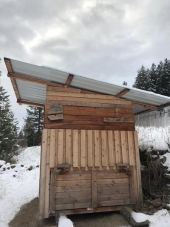Hi; First post at Permies;
We built a house in 1980 with an Earth Tube.. a brilliant (and ancient) concept, and it was off to a fine start, but had some key errors that required addressing.. and before we could do it there was a divorce and several graduations and relocations.. ah well! Just the same, I feel that the
energy available from the ground a scant few feet beneath our feet is far too great to ignore or shrug off. It does, however, require a renewed attention to the engineering realities that have been brought up.
Key to all this for me is that we make a very similar mistake with all our household mechanical systems, and build them into the house-system with 'nails, glue and rivets', so to speak, as if they were permanent fixtures not requiring the kind of modular accessibility that we take for granted in our cars and our computers. I want all the moving parts and the flows in my house attached with screws or bolts, and routed through dedicated mechanical access channels which will allow me and future owners to inspect, maintain, repair and replace these vital conduits whenever necessary via
access hatches, not with shovels and jackhammers. I don't pretend that moving our current design expectations to such a standard would be easy, quick or cheap.. but I do think that this goal is well worth moving towards, and every step I take on that route has convinced me that it is.
I do appreciate the ancient wisdom that we've inherited with classic building tools and materials.. but with Plumbing, Air Handling, Electricity, Communications and Heating/Cooling Systems, there is just too much tech development and system maintenance involved to bury these things 'permanently' behind plaster or under a slab. With so many of our energy and mechanical systems, we have hidden and shushed everything like they were back in the servants passages of the old days, and tried to live like these tools and forces ('energy slaves'.. as sometimes described) were best kept invisible and inaudible, hardly touching our awareness, at best.
Sorry for the soapboxing.. but the point for me with this topic is that these earth-tubes should be re-installed and rethought a bit, basically as others have said, with an eye towards that accessibility (and with the micro tech we have now, 'pipe pigs' for cleaning isn't a bad idea, really.).. and the proper designing of drainage, and I'd say a good bit more surface area/air-volume, within soils that you can also Insulate to whatever degree is possible, but without sacrificing a good thermal mass of soils in the process. Yes, it would be a 'lot', a helluva lot even.. and will certainly be called out as uneconomical under conventional building cost expectations.. but I think the long-term value of such a system would regain all of the investment, as big a hump as it would be to hurdle initially.
Lawton's video on the
greenhouse in Canada, which put their Annual Geothermal EarthTubes right under the core of the slab makes great sense to me, while that system also reheats the soils in the summertime with the
solar gain of the
greenhouse as well... ideally I would just have also kept an access hole at each end of the tube-trench, if not made a cellar trench that ran alongside these pipes, in order to be able to access this key mechanical system into the future. As with many renewable type systems, the startup costs might seem simply ridiculous to consider.. but taking the longest view you can, thinking of 'redigging' .. as you now must weigh into your own plans.. and similar barriers to fixing and improving an installed system, I have to suggest that it would be the right thing to work towards, no matter what today's beancounters will say.

















 1
1


































 1
1















